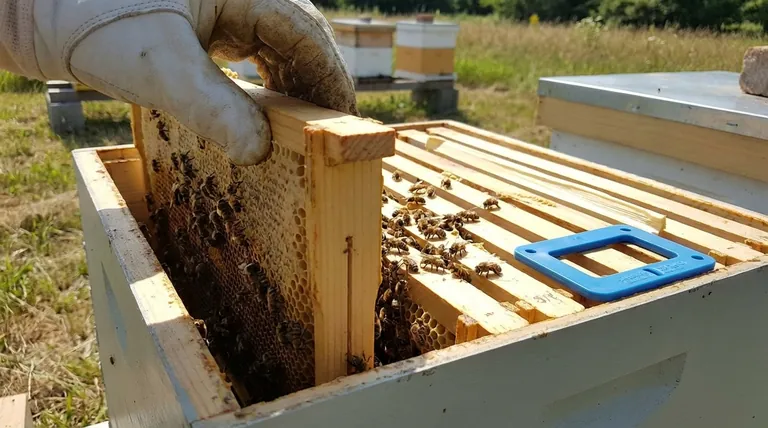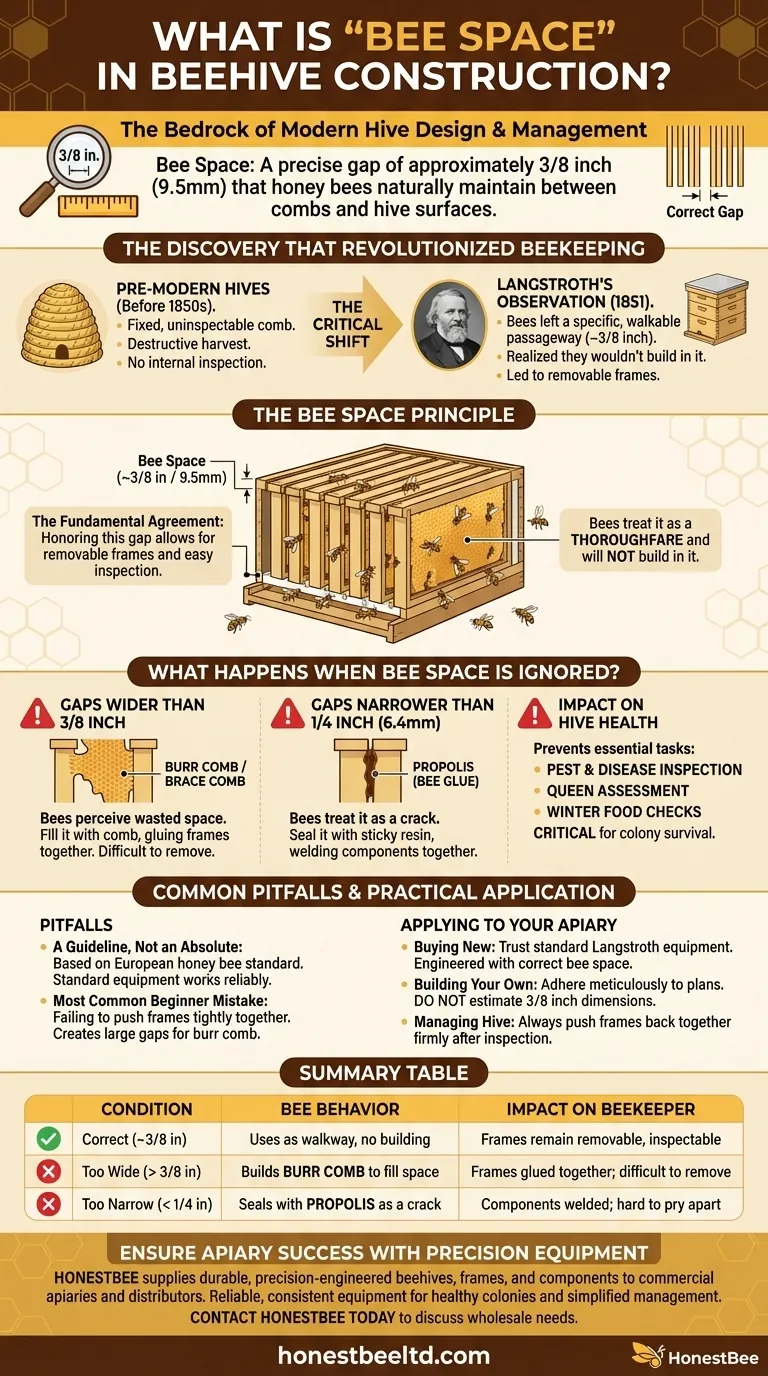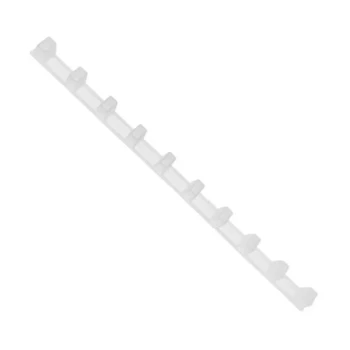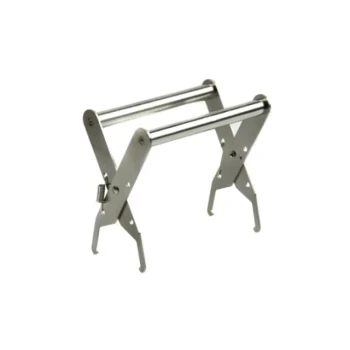In the world of beekeeping, one specific measurement forms the bedrock of all modern hive design and management. This is the bee space, a precise gap of approximately 3/8 of an inch (9.5mm) that honey bees naturally maintain between their combs and other hive surfaces. Adhering to this principle is the single most important factor that allows for a non-destructive, manageable beehive.
The concept of bee space is more than a simple measurement; it is the fundamental agreement between beekeeper and bee. Honoring this 3/8-inch gap allows for removable frames and easy inspection, while ignoring it results in a hive sealed shut with unwanted comb and propolis, making management nearly impossible.

The Discovery That Revolutionized Beekeeping
Before the 1850s, beekeeping often involved destroying the colony to harvest honey. The internal structure of the hive was a fixed, uninspectable mass of comb. The discovery of bee space changed everything.
The Problem with Pre-Modern Hives
Early hives, such as straw skeps or simple boxes, did not allow for internal inspection. Beekeepers could not check for disease, assess the queen's health, or remove honey without cutting out the comb, a process that was disruptive and often fatal to the colony.
Lorenzo Langstroth's Critical Observation
In 1851, the Reverend Lorenzo Langstroth observed that bees consistently left a specific, walkable passageway between their combs, roughly 3/8 of an inch wide. He realized they treated this gap as a thoroughfare and would not build in it.
From Observation to a Principle
Langstroth brilliantly deduced that if he built a beehive with frames and boxes separated by this exact gap, the bees would build their comb only within the frames. This would leave the frames free, removable, and inspectable, creating the basis for the modern Langstroth hive used worldwide.
What Happens When Bee Space is Ignored?
The bees' reaction to incorrect spacing is predictable and absolute. This is not a suggestion for them; it is a law of their nature.
Gaps Wider Than 3/8 Inch
If a space is significantly larger than 3/8 of an inch, bees will perceive it as wasted empty space. They will promptly fill it by building extra comb, often called burr comb or brace comb. This glues frames together and to the hive body, making them difficult or impossible to remove without tearing the comb and agitating the bees.
Gaps Narrower Than 1/4 Inch
If a space is significantly smaller than 1/4 of an inch (6.4mm), bees cannot pass through it. They will treat it as a crack in their hive wall and seal it with propolis, a sticky, resinous "bee glue" they collect from plants. This effectively welds frames and boxes together, requiring a hive tool and significant force to pry them apart.
The Impact on Hive Health
Both burr comb and propolis in the wrong places prevent the beekeeper from performing essential tasks. Without easily removable frames, you cannot inspect for pests like Varroa mites, check for signs of disease, verify the queen is laying eggs, or assess winter food stores, all of which are critical to the colony's survival.
Common Pitfalls and Nuances
While bee space is a powerful principle, a few practical details are crucial for success.
It's a Guideline, Not an Absolute
The 3/8-inch standard is based on the European honey bee. Some sub-species may work with slightly different spacing. However, for a vast majority of beekeepers, commercially produced equipment is standardized to this dimension, and it works reliably.
How Bee Space is Designed In
In a modern Langstroth hive, bee space is everywhere. It exists between the side of a frame and the hive wall, between the top bars of the frames in a lower box and the bottom bars of frames in a box above it, and above the top bars and under the inner cover.
The Most Common Beginner Mistake
A frequent error is failing to push the frames tightly together in the center of the hive box. This creates a large gap on either side, which the bees will invariably fill with burr comb, making future inspections difficult. The frames are designed to have bee space between them when they are all pushed together.
Applying Bee Space to Your Apiary
Understanding this principle is the key to working with your bees' instincts, not against them.
- If you are buying a new hive: Trust in standard Langstroth equipment. Manufacturers have engineered the correct bee space into every component, from the hive bodies to the frames.
- If you are building your own hive: Adhere meticulously to a reliable set of plans. Do not estimate or approximate the 3/8-inch (9.5mm) dimensions, as even small deviations can cause problems.
- If you are managing your hive: After an inspection, always push your frames back together firmly in the center of the box to maintain the correct spacing between them.
By respecting the bee space, you are creating a predictable environment that makes beekeeping a more effective and rewarding endeavor.
Summary Table:
| Bee Space Condition | Bee Behavior & Result | Impact on Beekeeper |
|---|---|---|
| Correct (~3/8 inch / 9.5mm) | Bees use it as a walkway; no building. | Frames remain removable and inspectable. |
| Too Wide (> 3/8 inch) | Bees build burr comb to fill the space. | Frames get glued together; difficult to remove. |
| Too Narrow (< 1/4 inch / 6.4mm) | Bees seal it with propolis as a crack. | Components get welded together; hard to pry apart. |
Ensure your apiary's success with equipment built to the precise bee space standard. HONESTBEE supplies durable, precision-engineered beehives, frames, and components to commercial apiaries and beekeeping equipment distributors. Our wholesale-focused operations ensure you get reliable, consistent equipment that promotes healthy colonies and simplifies management. Contact HONESTBEE today to discuss your wholesale needs and build a more productive partnership.
Visual Guide

Related Products
- Ergonomic Plastic Frame Spacer Tool for Rapid Hive Management Beekeeping
- Durable Plastic Frame Spacer
- Stainless Steel 9 Frame Hive Spacer Durable Precise for Commercial Beekeeping
- Multi-Function Hive Tool with Integrated Hammer for Beekeeping
- HONESTBEE Professional Bee Frame Machine for Side Bar Shaping
People Also Ask
- Why is it important to maintain accurate measurements in a Langstroth hive? Ensure Hive Health and Manageability
- What is the importance of having enough space in the bee yard? Prevent Disease Spread and Boost Hive Health
- What to do if bees are building combs between frames? A Guide to Fixing Burr Comb
- What is 'Bee Space' or 'Bee Passage' and why is it important in beekeeping? The Key to Modern Hive Management
- Why are my bees building combs between frames? Fix Cross Comb for Better Hive Management



















